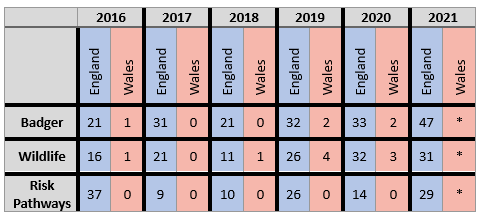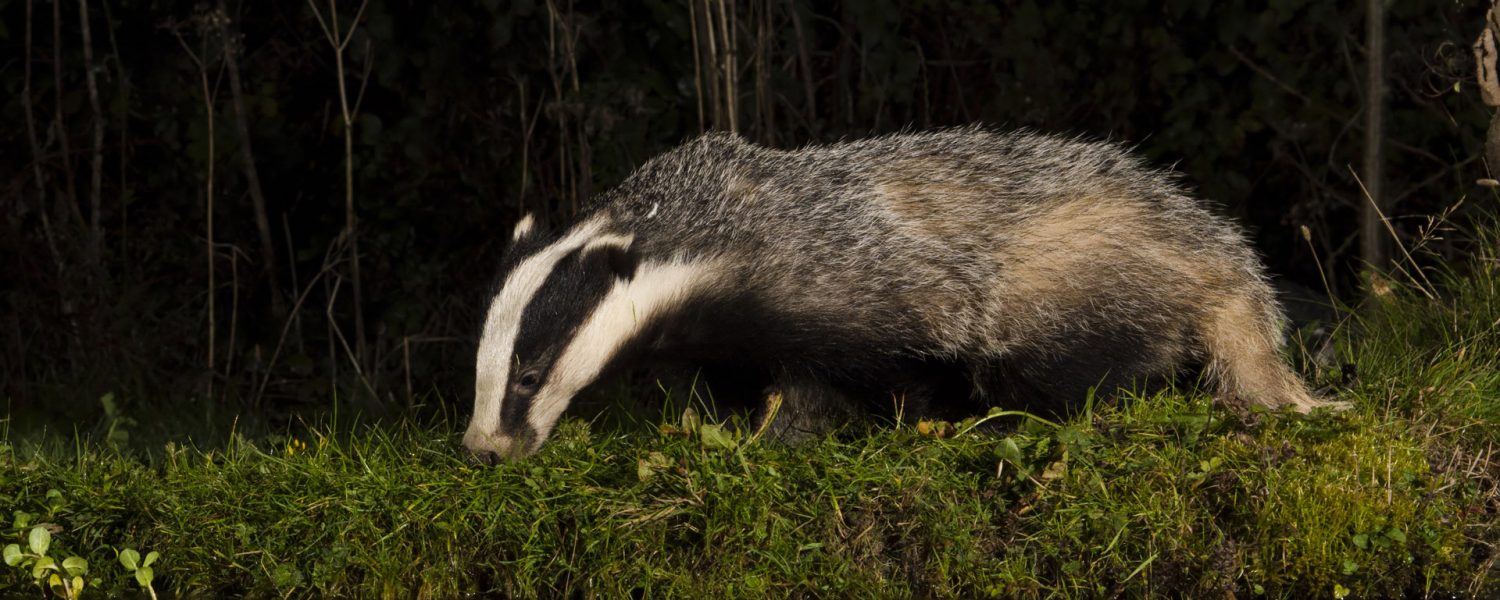The annual bovine TB epidemiology reports (1) for England and Wales, both compiled at APHA Weybridge, have historically had authors in common. More recently however, the reports no longer publish the identity of the authors. Why might this be? What we see now is a definite disparity in approach, presentation and implication.
The emphasis on wildlife and Risk Pathways Analysis (RPA) in the England reports is noticeable, compared to the Welsh versions (Table 1) which barely mention them. So whilst bTB is clearly the same disease in both countries, the attribution to wildlife, cattle movements and residual infection differs very markedly as you cross Offa’s Dyke.

Table 1. Mentions of the risk pathways approach and badgers and wildlife as a source of bovine TB infection in APHA reports for Wales and England 2016-2021. Note near absence of mention for Wales, while England has a growing obsession over wildlife involvement. Will attempts be made to force Wales to follow England’s scientifically unreferenced pathway?
These differences have occurred due to the use in England of un-evidenced data to support a policy that culls badgers in England, whereas in Wales no such policy exists (2). RPA was introduced in 2015 by APHA on a trial basis by vets using the newly updated Disease Report Form (DRF), and with the stated aim of identifying the source of bTB breakdowns, defined as ‘hazards’. In this trial, the pathway by which disease entered the bTB infected herd was to be decided by the investigating vet. The DRF provided a list of epidemiological hazard options to select; the option of attributing disease to wildlife was the default where attribution to a cattle source was not immediately obvious. The trial was quickly hailed as a success and expanded in 2016 with a few changes. In 2017 it was adopted by APHA as a standard recognised procedure for identifying the source of an infection, training vets to routinely misdiagnose.
Risk Pathways; a process hijacked by pro-badger cull advocates
APHA have not been able to provide scientific citation to validate the use of RPA protocol. Despite claiming since 2019 that they have a supporting paper in preparation for peer review and publication in a scientific journal, over three years later this has not appeared. It could perhaps be argued that RPA has all the hallmarks of being constructed by APHA to facilitate and support widespread badger culling, because that in effect is what it has done.
Since 2017 RPA has become the primary tool to implicate badgers as the source of the majority of incidents in England (2,3). Wales, in contrast, cites cattle movements, residual cattle herd infection and poor cattle purchasing decisions as the primary sources of bTB herd infection.
A trawl through recent APHA English County bTB reports reveals a plethora of statements about badgers which are not supported by qualifying scientific evidence. Many of these are stated as if they are settled science (they are not), or with descriminatory language. Below are a few examples from the Executive Summary of the APHA England 2021 epidemiological report (4) :-
“Eradication of bovine TB requires control of infection in both cattle and the main wildlife reservoir (badgers).”
“In 2021, as in previous years, herds located in the HRA (where there is high infection pressure from cattle and badgers),…….”
“For England, the source of infection with the highest weighted contribution was badgers (49%), followed by ‘Other or Unknown’ sources (17%). The most frequently considered sources of infection in the HRA were badgers (52%) and ‘Other or Unknown’ sources (16%). In the Edge Area, badgers constituted 52% of the considered source, followed by cattle movements (17%).“
“The existence of local reservoirs of M. bovis shared by cattle, badgers and other species; wildlife reservoirs of M. bovis are more common in the HRA and the western and northern parts of the Edge Area.”
Compare this with the extracts from the Executive Summary Wales Bovine Tuberculosis Surveillance Report 2020 (5), where there is not a single ‘wildlife’ reference.
“The risk of a herd becoming infected with TB is associated with factors such as herd density, herd size, production type, TB history and location. These factors contribute to the spatial pattern of TB in cattle herds across Wales. Dairy herds had a significantly higher TB incidence rate compared to beef herds, with this effect remaining after adjusting for herd size and location. Similarly, herds with more than 300 animals have the highest incidence rates, with this effect remaining after adjusting for herd type and TB Area.”
“The increase in recurrent infection (a TB incident occurring within the last two years) in cattle suggests this remains an important driver of infection in Wales.”
“Use of antibody blood tests increased by 85% in 2020 compared to 2019, with 11-13% of tests disclosing reactors in the high TB areas, west and east, intermediate TB area mid Wales.”
From 2017 onwards, the England epidemiological report has a map illustrating the areas of England where badgers are considered by (what is described as) “informed veterinary opinion” to be the source of bTB infection. This is veterinary opinion that has been informed by APHA’s flawed briefing of vets.The map suggests that badger contribution far outweighs that of cattle. Combined with DRFs, from which the map data is derived, it offers no evidence to support this veterinary judgement. There is a clear bias towards blaming badgers. It even references “infected badgers” within the text, with an admission from APHA that no badgers have been clinically tested.
There have already been 10 years of intensive badger culling in England, and there appears to be some intention to continue with so-called ‘epidemiological culling’ into the future, despite a lack of evidence as to efficacy (6). APHA’s epidemiological assessments try to justify this new style epidemiological culling, by ‘finger pointing’ badgers as the source of breakdowns.
Unscientific perpetuation of wildlife involvement persists
The unscientific claims of wildlife involvement in bTB persist. They are being pedalled via epidemiology reports that lack scientific evidence and backed by vested industry and veterinary interests. The speculative blaming of badgers as a source of bTB infection in cattle, without scientific evidence or justification, seriously undermines the whole bovine TB eradication policy.
APHA pride themselves on being a world class science establishment, supported by such statements as :
“Science continues to be fundamental to everything APHA does and we are committed to high quality science-based evidence for decision making and policy development. We will deliver this strategy over the next five years.”
The new model for epi-culling is not quite the model of scientific rigour APHA aspire to. Is it more a clear case of confirmation bias, remoulding and manipulating information to support a government policy that has tried to normalise removing large numbers of healthy badgers from the English landscape, contrary to high quality science based evidence and to correct handling of uncertainty and precautionary principles.
It has to be asked, has this manipulation been intentional? Is incompetence or even negligence the right perspective? Will public opinion continue to be ignored? Who exactly is pushing biased procedures? What level of pressure is being exerted from vested interests, and who is routinely interfering with government science?
References:
1. APHA 2022 Bovine Tuberculosis in England in 2021 Epidemiological analysis of the 2021 data and historical trends November 2022.
2. Griffiths, L.M., Griffiths, M.J., Jones, B.M., Jones, M.W., Langton, T. E. S., Rendle, R.M., & P.R. Torgerson. 2023. A bovine tuberculosis policy conundrum in 2023. On the scientific evidence relating to the Animal and Plant Health Agency/DEFRA policy concept for ‘Epidemiological’ badger culling. An independent report by researchers and veterinarians to Defra and the UK Parliament.
3. Critical evaluation of the Animal and Plant Health Agency report: ‘Year End Descriptive Epidemiology Report: Bovine TB Epidemic in the England Edge Area – Derbyshire 2018, E. Wright BVSc Cert VA Dip (AS) CABC MRCVS & S. Mayer BSc BVSc PhD MRCVS.
4. APHA 2021. Science Strategy 2021-26. Expertise with Impact. Online strategy.
5. APHA 2020. Epidemiology of bovine tuberculosis in Wales. Annual surveillance report
For the period: January to December 2020.
6. Langton TES, Jones MW, McGill I. Analysis of the impact of badger culling on bovine tuberculosis in cattle in the high-risk area of England, 2009–2020. Vet Rec 2022; doi:10.1002/vetr.1384
Discover more from The Badger Crowd - standing up for badgers
Subscribe to get the latest posts sent to your email.

